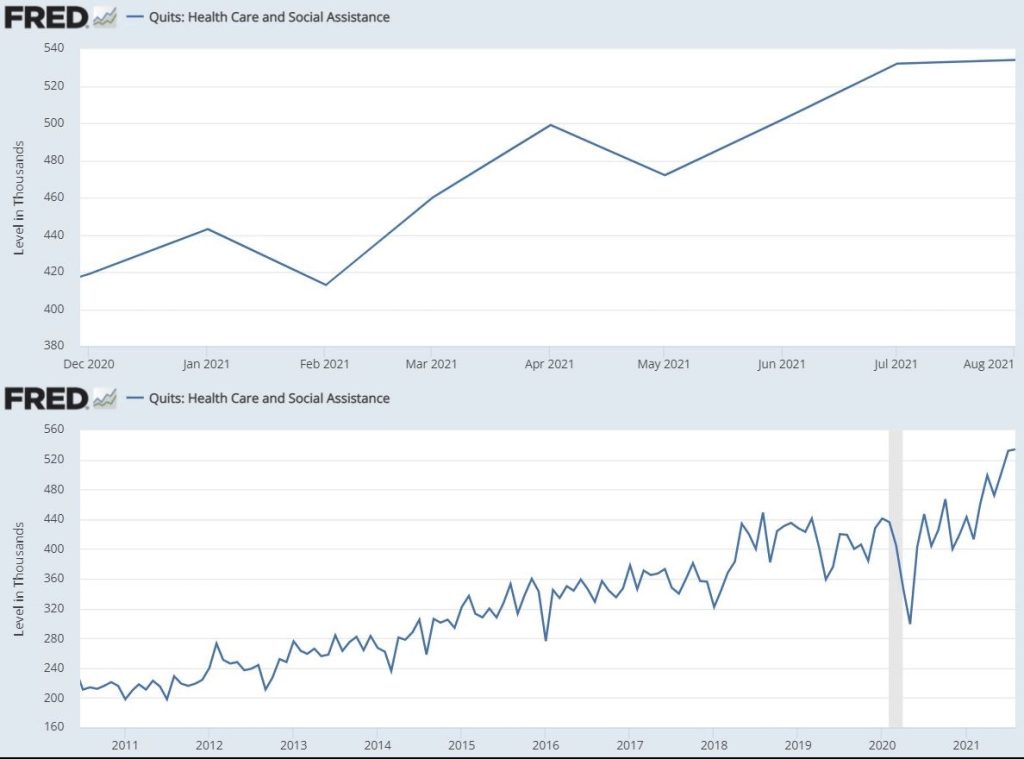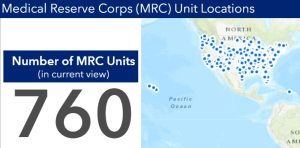Nurses, doctors, and frontline workers are walking out at private sector hospitals and medical facilities in record numbers, and the staffing shortages have prompted National Guard deployments nationwide (no one seems to be concerned about a resulting lack of National Guardsmen.) In this arrangement, anyone who quits will be replaced by someone who risks prison for refusing to deploy.
One of Biden's earliest actions in his capacity as 'President' was to sign a Memorandum directing FEMA to fully reimburse Governors' National Guard COVID-19 deployments. By mid-2020, all 50 states had mobilized some portion of their Air and Army National Guard for that purpose.

Free National Guard labor for corporations is not the only bailout the Federal government provides in this situation—not even close. FEMA uses your money to deploy free pandemic response help and is currently accepting requests for staffing on their website. The agency also provides a list of many other ways medical executives can get business expenses paid by chattel. They can try the Department of Health and Human Services (HHS), Veteran's Affairs (VA), or the Department of Labor (DOL). It's not just cash either; hospitals can get free PPE and medicine. I heard the government is really good at finding bargains, though.
Not to be outdone, CDC has 583 COVID-19 Response Staff deployed RIGHT NOW. They are diligently "strengthening the public health workforce" by "enhancing frontline public health capacity" to "intensify the coordinated response to COVID-19" so "hospitals can have another bailout."

There are other not-so-obvious programs you pay for, such as one that is run through HHS called Medical Reserve Corps (MRC). It is a network of deployment-ready volunteers that may "assist with activities to improve public health in their community—increasing health literacy, supporting prevention efforts, and eliminating health disparities." Though 'health literacy' and 'health disparities' are not explicitly defined, they may be referring to various efforts to rollout pharmaceutical products with relatively high-profit margins.
 An interactive map at MRC shows 760 units nationwide, each with hundreds of volunteers (we hope these are not the type of volunteers there to do whatever whenever for whomever). The MRC website says that about 200,000 of them have dedicated about 2 million hours to "COVID-19 response efforts." Not much detail is provided, but specific information on the variety of available Fauci merch is outside the scope of this article anyway.
An interactive map at MRC shows 760 units nationwide, each with hundreds of volunteers (we hope these are not the type of volunteers there to do whatever whenever for whomever). The MRC website says that about 200,000 of them have dedicated about 2 million hours to "COVID-19 response efforts." Not much detail is provided, but specific information on the variety of available Fauci merch is outside the scope of this article anyway.
CDC provides a huge list of "Service Organizations" as well. These are "Private Sector, Non-Governmental, and Academic Organizations" that are "supporting this critical effort by providing volunteers and paid staff." If you're looking for a reason to abolish it all, note that someone added the word 'critical' to this sentence on CDC's website.
One of these "Service Organizations" is the YMCA, and spoiler alert: No more free foosball for this family. You'd think that an organization like YMCA would have a COVID-19 campaign focused on something like health and fitness. Instead, we find that the Young Men's Christian Association has unveiled a sweeping "Vaccine Equity" initiative for the 'Y.' This woke word salad was written by the "Director of Health Equity, Access, and Engagement" and the "Vice President of Health Partnerships and Policy."
With whom, do you suppose, are the YMCA's health partnerships? What would YMCA's health policy be (if not to help Young Christian Men be wise about their bodily choices)? One would hope that YMCA is not liable for a significant number of hospitalizations based on such policy if one were me.

Another example of a pseudo-NGO surviving on COVID-19 response business is the CDC Foundation, created to manage an emergency staffing effort for state and local health departments. The foundation is currently hiring for Contact Tracing Systems Coordinator, Lab Technician, Epidemiologist, and Marketing Cartoonist, probably.
U.S. Digital Response (USDR) is another on CDC's list. USDR is hiring professionals in "civic tech" to "help identify gaps and challenges" with its "partners." Those partners are states and municipalities, for instance. USDR boasts of contracts with them, including COVID-19 "vaccinations, testing and tracing, and research and rapid response," which they are eager to note are made possible by support from the Rockefeller Foundation, whom no one has ever heard of before.
There are numerous options for the understaffed hospital, unlike your child's lemonade stand, which is always at risk of confiscation. And the money. The Coronavirus Aid, Relief, and Economic Security (CARES) Act sent out some $65 BILLION as a bailout of eligible hospitals and health professionals. That's a lot of cash to some of us.
Even with all those freebies, hospital administrators and executives can still be found saying it is not enough—and there are plenty of government officials saying it for them too. The goal is to get you to demand that your own money be used to help them pay for next time. Solving pesky supply and demand problems would otherwise require expertise, planning, and capital—one of which is still required in the medical industry.
The medical executives aren't conceding anything either. They say that there aren't enough skilled workers, and yet the protocols they have in place require multiple sets of particularly licensed individuals. They postpone or cancel "non-emergency" procedures so they have more room for denial of treatment. They say they were blindsided, and yet they've had decades of pandemics—flu season after flu season—and plenty of warnings.
For instance, this 2008 study evaluated how healthcare workers' attitudes would change during a pandemic, fearing that increased risk of exposure would reduce their "motivation" to work. The study opines that employers might be able to "alleviate the concerns and fears" of employees to keep them "motivated." Is that how that works? Allow me to "alleviate" your fear of "death by starvation" so that you may comfortably "give me all of your money."
There was another study in 2006, and this one did all the work for them. The authors developed a critical care triage protocol when a system becomes overwhelmed—the whole thing. Be skeptical for those who will do all the work for you, though. This paper suggests skipping patients unless they have "significant" organ failure. Further, its authors are eager to mention mechanical ventilators specifically within the first few sentences.
In case you didn't know, mechanical ventilators are most commonly used to cause organ failure—"significant" organ failure. If you doubt that, go on the side of the room for people who favor interventions for patients with lung ailments that involve laying down backward so that a tube can be inserted where breathing typically occurs.
Guidance for hospitals was everywhere. Consider the 2004 prediction hosted at the CDC from the Emerging Infectious Diseases Journal that said not having enough nurses would "constrain hospitals' ability to deal with future outbreaks." Further, the article suggested that "Understanding and improving nurses' working conditions could potentially decrease the incidence of many infectious diseases."
Ask a nurse on her way out whether hospitals saw the suggestion in 2004 and improved any working conditions.
With so much of this known, some still defend unaccountable hospitals and encourage blind acceptance of under-tested pharmaceuticals. They tend to paint a picture of a pre-existing staffing crisis exacerbated by selfish workers leveraging demand to bargain, strike, or seek opportunity elsewhere. Clear-eyed sages with ancient nutraceutical gut biomes guided by functioning taste buds, on the other hand, also reject experimental pharmaceutical injection as a condition of employment.


